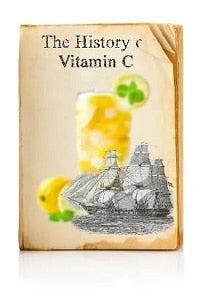Vitamin C is a very important nutrient that contributes greatly to our overall heath. Vitamin C makes proteins that are vital for our ligaments, tendons, blood vessels, immune system, skin and hair. It helps our body to repair cartilage, teeth and bones, and plays an important role in healing wounds. It’s also an antioxidant, which aids in strengthening the immune system and helps fight off diseases. Our bodies don’t naturally create or store Vitamin C, so we must get this essential nutrient from an outside source. The majority of animals, with the exception of guinea pigs, make their own Vitamin C. So these animals, combined with fruits and vegetables, can be an excellent source of Vitamin C for humans.
The need for Vitamin C was certainly known much longer than the discovery of it. Many people had Vitamin C deficiencies and were suffering from many health issues from malnutrition. Sailors experienced slow healing wounds, hemorrhaging below the skin, sore loose teeth and bleeding gums. This is because there was once a shortage of Vitamin C sources on ships. This unfortunate shortage, and knowledge, of Vitamin C eventually led to an adverse disease called scurvy. Scurvy would often be the tenebrous result of sailors traveling for long periods of time without fresh food and water supplies. This horrible disease quickly caused many deaths because sailors were voyaging so far away from where they could receive prompt and proper treatment. By the end of the 15th century, scurvy was the major cause of mortality, and impairments, in sailors.
Scurvy is what ultimately encouraged physicians to dig deeper into the importance of nutrients. In 1753, scurvy was finally linked to nutrition deficiency by the British medical community. Then in 1769, a young British physician named William Stark began performing nutrition experiments on himself. For 31 days, Stark ate only bread and water. Then Stark began to gradually add more foods. Some of these foods were milk, goose meat, figs and olive oil. Within two months, Stark’s gums were sore and bleeding. Stark died approximately seven months later due to malnutrition and what had very likely become scurvy. He had adequate meat in his diet but immensely lacked fruits an vegetables.
William Stark’s misfortunate experiments weren’t done in vain though. His experiments helped other physicians find out what was lacking in the many diets that were leading to such awful complications and this terrible disease. A Scottish physician, James Lind, had been observing the importance of the health benefits provided by lemon juice and citrus fruits several years before William Stark’s death and recommended the obligatory consumption of lemon juice and citrus fruits by British sailors. This recommendation was accepted and put into effect by 1795. Lime juice had to be carried on all naval vessels and scurvy in the British sailors gradually disappeared. At this time, although it was now well known that citrus fruit had important preventative and curative properties these sailors were lacking, no one had yet discovered the root of those preventative and curative properties; a vital ascorbic acid, later known as Vitamin C. A few years later, an intelligent Hungarian researcher, named Albert Szent-Gyorgyi, pin pointed and identified Vitamin C. In 1937, Albert Szent-Gyorgyi was awarded the Nobel Prize in Physiology or Medicine for his miraculous discovery. Today Vitamin C is just as vital for our health as it was decades ago, and over the years, this nutrient has only been found to provide us with even more benefits.


